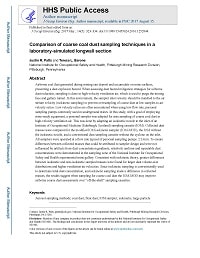Mining Publication: Comparison of Coarse Coal Dust Sampling Techniques in a Laboratory-simulated Longwall Section
Original creation date: May 2017
Authors: J Patts, T Barone
Airborne coal dust generated during mining can deposit and accumulate on mine surfaces, presenting a dust explosion hazard. When assessing dust hazard mitigation strategies for airborne dust reduction, sampling is done in high-velocity ventilation air, which is used to purge the mining face and gallery tunnel. In this environment, the sampler inlet velocity should be matched to the air stream velocity (isokinetic sampling) to prevent oversampling of coarse dust at low sampler-to-air velocity ratios. Low velocity ratios are often encountered when using low flow rate, personal sampling pumps commonly used in underground mines. In this study, with a goal of employing mine-ready equipment, a personal sampler was adapted for area sampling of coarse coal dust in high-velocity ventilation air. This was done by adapting an isokinetic nozzle to the inlet of an Institute of Occupational Medicine (Edinburgh, Scotland) sampling cassette (IOM). Collected dust masses were compared for the modified IOM isokinetic sampler (IOM-MOD), the IOM without the isokinetic nozzle, and a conventional dust sampling cassette without the cyclone on the inlet. All samplers were operated at a flow rate typical of personal sampling pumps: 2 L/min. To ensure differences between collected masses that could be attributed to sampler design and were not influenced by artifacts from dust concentration gradients, relatively uniform and repeatable dust concentrations were demonstrated in the sampling zone of the National Institute for Occupational Safety and Health experimental mine gallery. Consistent with isokinetic theory, greater differences between isokinetic and non-isokinetic sampled masses were found for larger dust volume-size distributions and higher ventilation air velocities. Since isokinetic sampling is conventionally used to determine total dust concentration, and isokinetic sampling made a difference in collected masses, the results suggest when sampling for coarse coal dust the IOM-MOD may improve airborne coarse dust assessments over “off-the-shelf” sampling cassettes.

- Characterization of Coal Mine Dust Size Distribution, Chemical Composition, and Source Contributions
- Determining the Spatial Variability of Personal Sampler Inlet Locations
- Enhanced Utilization of Personal Dust Monitor Feedback
- Equivalency of a Personal Dust Monitor to the Current United States Coal Mine Respirable Dust Sampler
- Miners' Views about Personal Dust Monitors
- Miners' Views About Personal Dust Monitors
- Performance of a New Personal Respirable Dust Monitor for Mine Use
- Size-dependent Metric Analysis of Respirable Coal Mine Dust (RCMD)
- Trend in Black Lung Cases Concerns NIOSH Researchers
- Using CPDM Dust Data